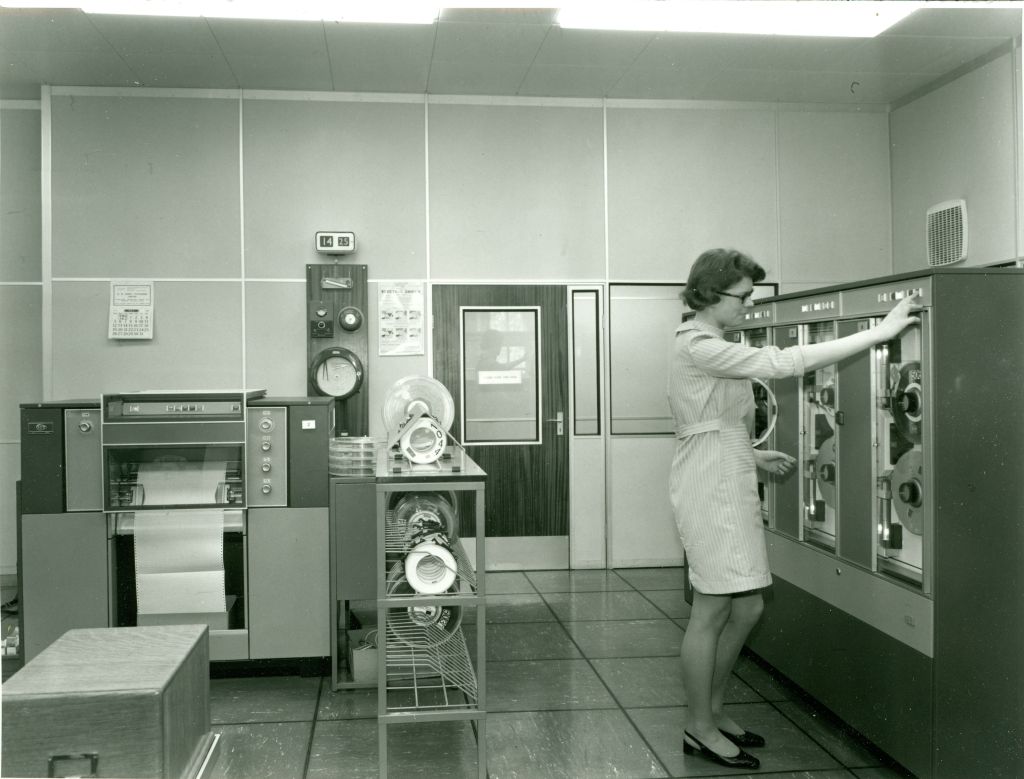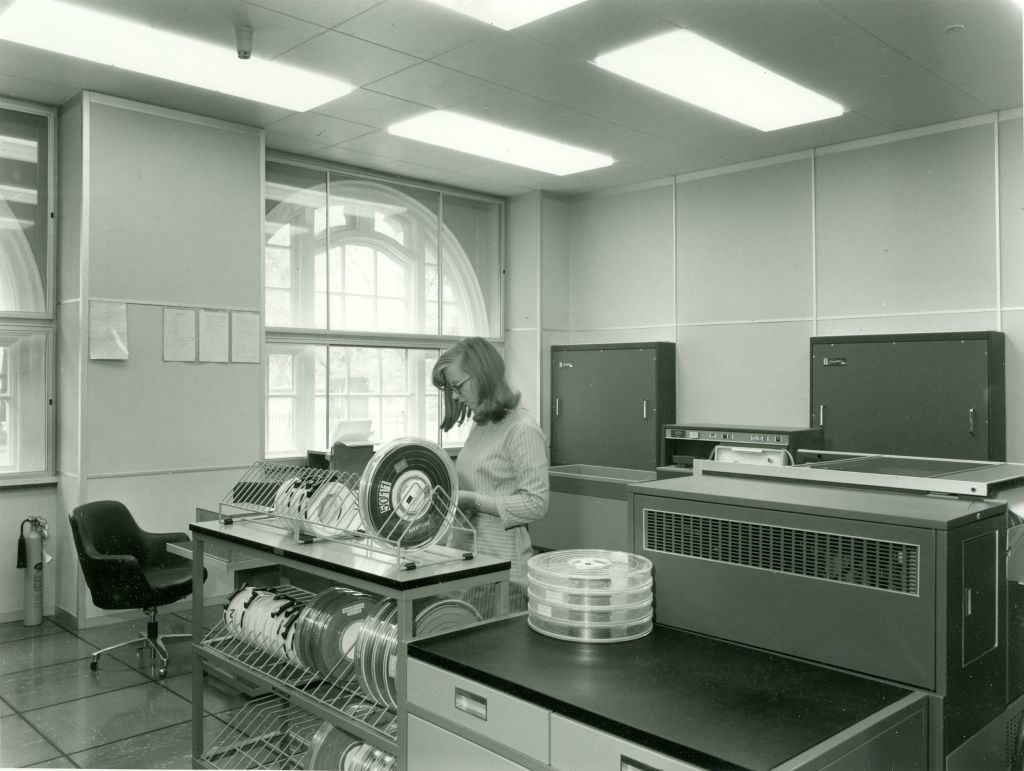The mid-1960s saw huge developments in computing, as technology moved on from vacuum tubes and discrete transistors to the integrated circuit, allowing the development of what became known as mainframe computers. Combined with ‘Moore’s law’ – the observation that the number of transistors in an integrated circuit doubles around every two years – these developments meant that the capabilities and possible applications of computers exploded from this time onwards. It was in this environment in 1966 that the Church Commissioners decided to purchase a computer, the process of which is recorded in the meeting papers of the General Purposes Committee recently added to the online archives catalogue.
Tenders were received from International Computers and Tabulators (I.C.T.) and National Cash Register Company for a suitable system, with the I.C.T. tender proposing the implementation of work being carried out on the computer proceeding in three phases, starting with payroll before progressing to estates and then fund accounting. A British I.C.T. 1901 model was ordered from International Computers Ltd (I.C.L.) and installed on 1st January 1968, at a cost of £64,900 (equivalent to £875,000 in 2022).[1] An introductory guide for staff describes how the computer consisted of five units: a Paper Tape Reader (speed 300 characters/second), a Central Processor (16,000 words of core storage; ‘consists of transistors and a very large number of wires’), a Four-tape Magnetic Tape Unit (speed 20,800 characters/second), a Line Printer (speed 300 lines/minute), and a Typewriter Console. The first four of these units were each 5’ high and 5’ long, and as can be seen in the photographs (these are currently accession number C-2014-18), early third-generation computers filled a whole room.[2]

Despite this, the guide describes the computer as ‘a comparatively small installation, but nevertheless highly efficient and capable of carrying out all the accounting and statistical work that we have. It will affect our work in varying degrees, largely by eliminating much that is routine and tedious … How does it work? Basically, in exactly the same way as we do, except that it works very much faster, uses binary code, very rarely makes a mistake and never gets tired.’
There were five elements to the computing activities:
- Input – reading punched paper tape and converting it to magnetic impulses using binary code.
- Processing – taking the converted data and performing defined processes.
- Storage – on magnetic tapes, each 2,400’ in length and holding 16 million characters; one reel held the equivalent of 25 novels and could be read and recorded by the Magnetic Tape Unit in 12.5 minutes; it was anticipated 100 reels would be needed.
- Output – the Line Printer.
- Control – a master program Executive occupied 2,000 words of core storage on the Central Processor and allocated memory and peripherals as needed.
To operate the new computer the Church Commissioners were aware of the need to recruit new staff and retrain others. To be recruited were a Systems analyst, to get down on paper in complete detail and correctly in sequence every stage of the operation, and a Programmer, to write out the instructions for the computer to carry out its operations using the COBOL (common business-oriented language) programming language. Staff being reassigned to computer work were to undergo training courses lasting up to four weeks to provide another Systems Analyst, two more Programmers, and two or three Computer Room Operators, as well as Punch Operators and Verifiers required to convert figures and information onto paper tape, and a Clerical Section for checking, editing, and control of documents to be fed into computer.
The records show that by December 1971 the computer was already being used for a wide range of functions, but the General Purposes Committee was asked to approve the purchase of discs (considered more flexible and offering faster processing and access to information, as well as access to new programs), a fast printer (the existing printer was said to be ‘extremely slow’ and insufficient for future needs, while a new printer would eliminate the need for shift work), and a more powerful central processor.[3] These upgrades were estimated to cost £75,000 in 1971 – equivalent to £835,000 in 2022.
However, a July 1975 report notes increasing trouble with the computer’s central processor and the magnetic tape units, and given that ‘most of the financial and statistical work of the office is now handled by the computer and it is no exaggeration to say that this aspect of the work of the Commissioners, particularly the work connected with clergy stipends and pensions, could not be undertaken without the help of a computer’, it was considered necessary to seek a major upgrade. This was to include using discs rather than magnetic tape to allow ready access, and the possible introduction of Visual Display Units (VDUs) to show information contained on these discs. The report recommends upgrading to a 1901T system (60,000 words core storage), a three-disc unit (capacity of 180m characters), a two-magnetic tape unit (80,000 characters/second), VDUs and a printer, and a new input system to replace the hole punching paper tape system.[4] The cost of this major upgrade in 1976 was said to be £270,000 – equivalent to a staggering £1,603,000 in 2022.

By 1980, the list of work handled by the computer was impressive:
- Clergy and Staff pay, involving PAYE and National Insurance contributions.
- Register of clergy incomes from all sources.
- Clergy and Clergy Widows’ pension payments.
- Church property and investment mortgages.
- Parsonage building and improvement funds.
- Corn Rents.
- Records relating to each of the Commissioners’ c.17,000 properties.
- Clergy Register.
- Diocesan stipends funds.
- Preparation and recording of cheques issued and cashed (c.200 per day).
- Renting use of computer to Investment Office.
However, following a 12-month review, a report concluded the computer was reaching the end of its useful economic life: it was no longer able to handle the workload (due to age and lack of processing power), new computers offered better access and editing functions via VDUs (known as an ‘on-line system’), heads of department viewed a new ‘on-line system’ as offering savings in manpower and stationery costs, and the systems originally designed were out of date and needed to be re-written.[5]
Rather than upgrade the existing computer, the decision was made to purchase one of the new, more advanced models from the varied range offered by ICL by this time. It was thought that this would limit the need for error-prone batch processing of data, allow immediate access to information via VDUs and make it possible to have VDUs in multiple buildings, lead to improved job satisfaction as the perceived control of data resides with the user rather than the computer, and, since data would be easier to update, eliminate reliance on out-of-date information. This would cost £346,000 in 1980 – equivalent to £1,308,000 in 2022.
The Church Commissioners commitment to information technology at an early date is admirable, even if the sums being spent seem outlandish today. In a modern office, where everyone works on a laptop accessing shared drives and connected to the internet, it’s easy to forget how far computing technology has come and to take for granted the ubiquity of computers now.
[1] Equivalent prices throughout have been calculated using: https://www.bankofengland.co.uk/monetary-policy/inflation/inflation-calculator [Accessed 14/02/2023].
[2] CC/GPC(68)MTG2.
[3] CC/GPC(71)MTG8.
[4] CC/GPC(75)MTG7.
[5] CC/GPC(80)MTG6.

